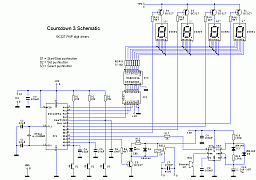 Main schematic (in PDF format) |
 Power supply schematic (in PDF format) |
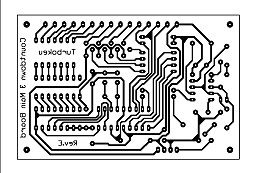 PCB layout of the main board |
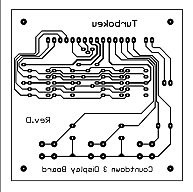 PCB layout of the display board |
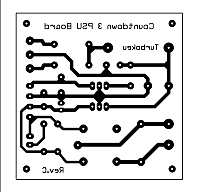 PCB layout of the power supply board |
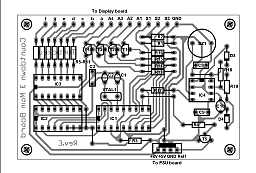 Component layout of the main board |
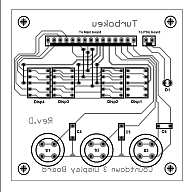 Component layout of the display board |
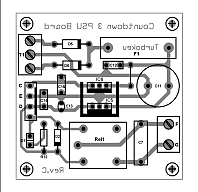 Component layout of the power supply board |
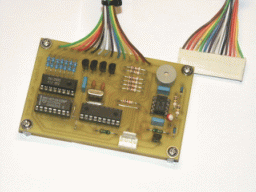 Picture of the (1st prototype of the) main board |
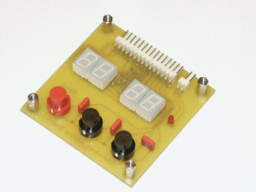 Picture of the display board |
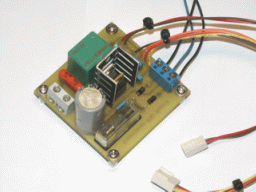 Picture of the power supply board |
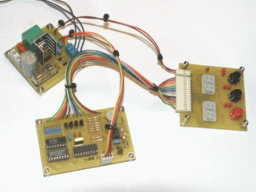 Picture of the complete project |
As I used an old scanner enclosure to fit the 4x15W Cleo lamps from a second hand tanning Philips device, I had to develop a new display-keyboard PCB (due to space constraints on the front panel of the scanner):
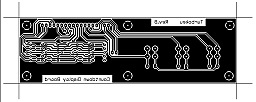 Alternate display board PCB layout |
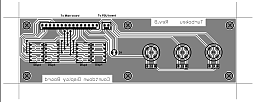 Component layout of the alternate display board |
Hardware modifications on Stan's project:
- I used Common Anode displays instead of Common Cathode ones.
- I used a 4543B BCD to 7-segment decoder-latch instead of the original 4511
because of the better display of the "6" and the "9".
- BC327 PNP digit driver transistors with Icmax=0.5A instead of standard NPN
transistors.
- Added relay for lamp switching (Thanks to Aurelien).
- Added ULN2003A Darlington Transistor Array on 4543 outputs (max. output for a
4511 or 4543 is 10mA/segment).
In the modified version it's about 30mA/segment to compensate for the 25% duty
cycle of the displays.
- Added +5V regulated power supply.
- Added +8V regulated power supply for the ULN2003A.
- Added 10nF debounce capacitors to the pushbuttons.
- Added Piezo buzzer instead of speaker (again, thanks to Aurelien).
- Added a 555 Timer as astable multivibrator for 1Hz pulsed output to buzzer
(the 555 is triggered by its reset input).
Software modifications :
- Modified BITPAT table to accomodate for Common Anode displays.
- Added initialization of PORTB and flags.
- Modified EE2D, STARTCNT and SOUNDALARM routines to accomodate for the
modified INTERRUPT routine:
- In the original INTERRUPT routine from Stan, because of the bit pattern
writes to PORTB (bit0 to 3), bits 4 & 5 (buzzer & relay) were always
written back as 0, which needs a continuous update of these bits in the
MAINLOOP & SOUNDALARM routines. This is why in the original schematic and
the one from Aurelien there are 47µF capacitors through diodes to prevent the
relay or the buzzer to deactivate every time the PORTB bit goes to 0.
I corrected this by modifying the INTERRUPT routine this way :
PORTB bits :
lower nibble :
b0-b3: bit pattern (=1,2,4,8 for NPN transistors, =hex 0E,0D,0B,07 for PNP
transistors)
higher nibble :
b4: buzzer output
b5: relay output
b6: SET PB sense line
b7: START PB sense line
Before :
MOVF DIGIT,W ; Load digit number to lit
in W
CALL BITPAT ; Get bit pattern from table
MOVWF PORTB ; write to PORTB
As you can see bits b4 & b5 are always written to PORTB as 0.
After :
MOVF PORTB,W ; Read PORTB
MOVWF TEMP ; Store result in TEMP register
MOVF DIGIT,W ; Load digit number to lit in W
CALL BITPAT ; Get bit pattern from table
XORWF TEMP,W ; Do exclusive OR with register TEMP
MOVWF PORTB ; Write result to PORTB
So bits b4 & b5 are written back to PORTB in their original state.
Files included in CNTDWN3.ZIP :
- CNTDN.ZIP : original files from Stan Ockers
- CNTDWN3PNP.ASM : Assembler program listing for 16F84 &
PNP digit driver transistors
- CNTDWN3PNP.HEX : Idem in Intel HEX-format
- CNTDWN3-628-PNP.ASM : Assembler program listing for 16F6x8 &
PNP digit driver transistors
- CNTDWN3-628-PNP.HEX : Idem in Intel HEX-format
- CNTDWN3PNP.PDF : Countdown3 schematic for PNP
- CNTDWN3PSU.PDF : Power Supply schematic
- CD3MB.GIF : Main board PCB layout
- CD3DISP.GIF : Display board PCB layout
- CD3PSU.GIF : Power supply board PCB layout
- CD3DISPKEYB.GIF : Alternate display board PCB layout
- MBCOMP.GIF : Main board component layout
- DISPCOMP.GIF : Display board component layout
- PSUCOMP.GIF : Power supply board component layout
- DISPKEYBCOMP.GIF : Alternate display board component layout
- COMPLIST.TXT : Component list
- CNTDWN3.TXT : This text
Also included :
- CNTDWN3PNP.CKT : Countdown3 schematic with PNP digit driver
transistors in Circuitmaker2000 format
- CNTDNPSU.CKT : Power supply schematic in Circuitmaker2000
format
- CD3MB.PCB : Main board PCB layout in Circad'98 format
- CD3DISP.PCB : Display board PCB layout in Circad'98 format
- CD3PSU.PCB : Power supply board PCB layout in Circad'98
format
- CD3DISPKEYB.PCB : Alternate display board PCB layout in
Circad'98 format
- Some digital JPG pictures of the finished project
Download complete ZIP file (672KB) : cntdwn3.zip